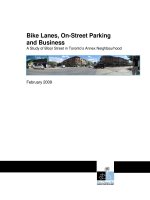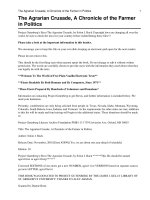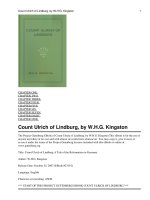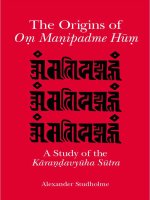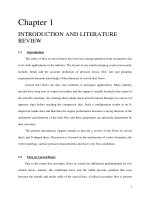A study of the flow in an s shaped duct 7
Bạn đang xem bản rút gọn của tài liệu. Xem và tải ngay bản đầy đủ của tài liệu tại đây (108.91 KB, 5 trang )
81
Chapter 7
CONCLUSION
7.1 Summary and Conclusion
Flows in curved ducts and S-shaped ducts are often accompanied by swirls, flow
separation and stream-wise vortices. Due to centreline curvature, these flows are subjected to
centrifugal forces as fluid “particles” move around the duct bend. As a reaction force, a radial
pressure gradient develops on the curved side walls of the duct. A higher pressure on the
outside wall of the bend, and a lower pressure along the inside wall of the bend, results in a
radial pressure gradient which drives the flow along the periphery of the side wall from the
high pressure side to the low pressure side of the bend. A helical, swirling, vortex motion (or
secondary flow) is thus set-up.
Since the dominant forces in the curved duct and S-shaped duct flows are centrifugal
force and radial pressure gradient, a non-dimensional parameter involving a ratio of these two
forces should produce a collapsed curve that is independent of the ducts’ curvature ratio. The
thesis explores this proposition by introducing a dimensionless parameter, , which is related
to the ratio of the two stated forces, and applies it to the flow in circular and square cross
sectioned 90
O
curved ducts and S-shaped ducts. With defined as the ratio of radial pressure
gradient to centrifugal force via dimensional analysis, the thesis proceeds to show that can
be calculated by multiplying (i.e. dimensionless pressure difference between the side
walls) with half the curvature ratio of the curved duct. Using the available data from the
literature and the present experimental study, partially collapsed curves are obtained when
(s/S
O
) is plotted against the normalized duct centre-line coordinate, (s/S
O
), for circular and
82
square cross sectioned 90
O
curved ducts as well as S-shaped ducts of different curvature
ratios. The existence of a partially collapsed curve shows that is an important non-
dimensional parameter governing the flow in curved and S-shaped ducts. Some data scatter in
the plots are noted and explained. These observations are presumably traced to factors like
existence of flow separation, presence of stream-wise vortices near the curve walls and the
different experimental conditions (e.g. boundary layer thickness) among the literature
sources. To verify this assumption, and to shed more light on the effects flow separation and
stream-wise vortices have on (s/S
O
), vortex generators were installed to change the flow
conditions. It was shown that vortex generators suppress flow separation and accompanied by
changes in the configuration of near-wall stream-wise vortices. The latter changes the side
wall pressure distribution and hence the variation of (s/S
O
) with (s/S
O
). This implies that the
variation of (s/S
O
) with (s/S
O
) is indeed dependent on the existence of flow separation and
the vortex configuration of the near wall stream-wise vortices.
Since the variation of radial pressure gradient and centrifugal force is influenced by
vortical structures and swirling flow in curved and S-shaped ducts, the thesis proceeded to
study in detail these structures and the swirl development in high curvature, square cross
sectioned S-shaped ducts. The experimental study was performed on three square cross
sectioned S-ducts with curvature ratios and Reynolds numbers that are higher than those
available in the literature. Benchmarking of the present experimental data with those in the
literature was also performed. The result shows that a dominant swirl flow that developed in
the first bend of the S-duct was largely attenuated in magnitude in the second bend of
opposite curvature due to the formation of swirl flow of the opposite direction. Surface oil
flow visualization conducted on the bottom wall showed the existence of a clear dividing or
separation line, with a similar separation line expected to occur on the top wall due to
symmetry of the S-duct test section. This separation line is caused by the flow of opposite
83
swirl which meet, and subsequently separate along this line. In addition, stream-wise vortices
were found to form, either as a counter-rotating vortex pair or just a single vortex, along the
outer wall of the second bend. Their formation mechanism was explained using the Squire
and Winter’s formula. The initial swirl that developed in the first bend of the S-duct led to a
redistribution of the stream-wise velocity close to the near-side wall
This initial swirl altered
the velocity gradient (
z
u
∂
∂
) close to the near-side wall in the vicinity of the inflection plane
of the S-duct. When the flow enters the second bend, this velocity gradient resulted in a
redistribution of stream-wise (or axial) vorticity with the formation and growth of stream-
wise vortices. Based on the experimental data and flow visualisation, a qualitative flow
model is proposed.
To further validate the proposed flow model, cross flow velocity measurements at 9
internal planes of the S-duct was performed at the same Reynolds number and boundary layer
thickness as proposed in the flow model. The results generally conform to the flow features
proposed in the flow model. These include the initial swirl generated in the first bend and its
subsequent reversal of swirl direction in the second bend, the presence and formation of the
separation line at the bottom floor and finally, the formation of stream-wise vortices on the
outer wall of the second bend. These cross flow measurements also indicate that the stream-
wise vortices are generated initially near the inflection plane of the S-duct (i.e. the plane
between the first and second bend).
The multiple planes, cross flow measurements were extended to investigate the effects
of inlet boundary layer on swirl development and on the formation of stream-wise vortices in
S-duct. Three different Reynolds numbers and two boundary layer thicknesses were
investigated. It was shown that for all the Reynolds number investigated, increased inlet
boundary layer thickness led to increased swirl flow in the first bend of the S-duct. The
difference in the swirl magnitude led to velocity gradients of
∂
u/
∂
z produced in the vicinity of
84
the inflection plane of the S-duct, close to the near-side wall. The subsequent growth of
stream-wise vortices of different configuration in the second bend can be traced to this initial
difference in
∂
u/
∂
z near the inflection plane of the S-duct.
Finally, different flow control techniques were investigated. The focus is to assess the
effectiveness of VGs, tangential blowing and VG jets to control flow separation, to reduce
total pressure loss, to attenuate swirl magnitude and to improve flow uniformity at the S-duct
exit. The three methods were shown to be effective in suppressing flow separation and
reducing total pressure loss but seem to be ineffective in attenuating the swirl magnitude or
improving flow uniformity at the exit. In fact, these three methods increase the swirl in the S-
duct as a result of an increase in the radial pressure difference between the side walls. The
increase in the radial pressure difference was due to the elimination of flow separation in the
first bend and the changes in the configuration and position of stream-wise vortices on the
outer wall of the second bend. These findings indicate competing parameters for improving
the performance of flow in S-ducts.
7.2 Recommendations for future work
(1). The onset and formation of Dean vortex in a curved duct is known to be a bifurcation
process. Numerically and theoretically, the critical Dean number range and the angular
position along the curve duct at which Dean vortex forms can be determined quite accurately.
However, experimentalists are relying on flow visualisation and in-plane velocity
measurements at discrete (or large) angular position along the duct to determine these two
critical quantities. To circumvent this limitation, the variation of (s/S
O
) with (s/S
O
) (as
presented in Chapter 3) can be extended and applied to curved ducts of larger angular bends
(say 270
O
) to determine the critical Dean number and angular position at which Dean vortex
forms. When a pair of Dean vortex forms on the outer wall of the bend, it is expected that the
85
variation of (s/S
O
) with (s/S
O
) should show an inflection (or a change in gradient) in its
trend. Compared to the case where Dean vortex is absent, the unsteady Dean vortex should
change the pressure distribution on the outer wall of the bend and hence the radial pressure
gradient within the bend. The angular position and Dean number at which the inflection
appears will give a quantitative indication to these two critical quantities. However, extra care
must be taken to drill small pressure taps that do not introduce unnecessary disturbances to
the flow and the angular resolution between each pressure tap on the wall must be fine
enough to capture the presence of the said inflection.



